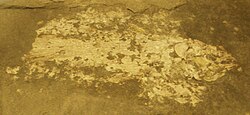| Ticinepomis Temporal range: Lower Ladinian, | |
|---|---|
 | |
| Fossil | |
 | |
| Reconstruction | |
| Scientific classification | |
| Domain: | Eukaryota |
| Kingdom: | Animalia |
| Phylum: | Chordata |
| Clade: | Sarcopterygii |
| Class: | Actinistia |
| Order: | Coelacanthiformes |
| Suborder: | Latimerioidei |
| Family: | Latimeriidae |
| Genus: | † Ticinepomis Rieppel, 1980 |
| Type species | |
| †Ticinepomis peyeri Rieppel, 1980 | |
| Other species | |
| |

Ticinepomis is an extinct genus of coelacanth lobe-finned fish which lived during the Middle Triassic period in what is now Switzerland. It contains two species, T. peyeri and T. ducanensis. [2]
Specimens of the species T. peyeri, which was named after Bernhard Peyer, are most common in the Besano Formation (or Grenzbitumenzone) of Monte San Giorgio in canton Ticino. [3] Other coelacanths from Monte San Giorgio include a larger species (tentatively referred to Holophagus picenus ) from the Besano Formation, [4] and a species of Heptanema from the Meride Limestone. [5]
Larger Ticinepomis specimens have been found in the Prosanto Formation of canton Graubünden, originally referred to as Ticinepomis cf. T. peyeri. [6] A revision showed that this material belongs to a new species, T. ducanensis, remains of which were also discovered in the Besano Formation of canton Ticino. [2] The Prosanto Formation also produced the unusual coelacanths Foreyia and Rieppelia .




